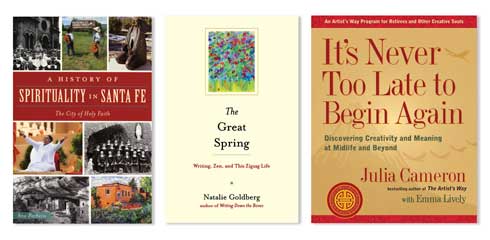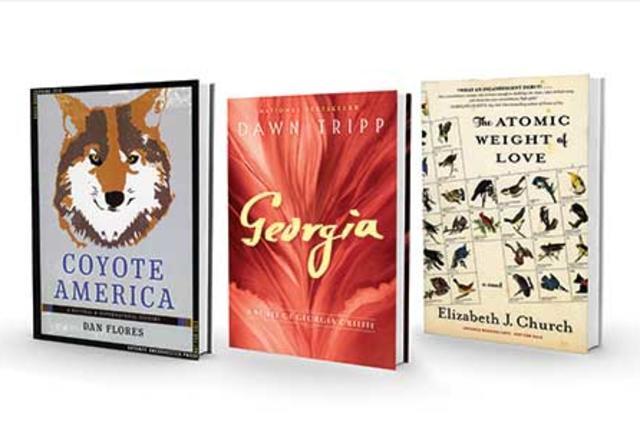COYOTE AMERICA:
A Natural and Supernatural History
BY DAN FLORES (Basic, 2016)
Just about everyone has some kind of coyote story. Native Americans have ancient myths, Central Park joggers have legendary encounters, every kid with a bowl of cereal has Road Runner cartoons. Yet for all that, America’s most common large predator remains strangely unloved. Has any icon since the Big Bad Wolf been so maligned and mistreated?
Dan Flores, a professor emeritus at the University of Montana, aims to properly acquaint readers with Canis latrans. Inspiration for his fascinating scientific and cultural history comes in part from Flores’ own residence outside Santa Fe. “It is sometimes easy to think, in the summer New Mexico dusk,” he writes, “that what begins with a single coyote pouring out his soul across these canyons and dwarf forests has by morning rippled in concentric circles from this spot of origin across the full sweep of North America, as far as the last coyote at the farthest edge of the last ripple.”
As it happens, that’s basically how coyotes got their start. Though their evolutionary origins lie in the Southwest—where remains are common at Chaco archaeological sites—a series of migratory ripples have carried the creatures far and wide, often into the choppy wake of civilization. When a member of the Lewis and Clark expedition first noted the existence of a “Priari Wolf,” he didn’t know that Aztecs in central Mexico had been calling it a coyotl for centuries.
Coyote America is built around the species’ knotty relationship with human neighbors. Traditional tales about the deity Coyote, steeped in what Flores calls a “Cormac McCarthy–like appraisal of human motives,” fixed the animal in the popular imagination as a cynical trickster. The questionable reputation—plus a habit of chewing up chickens and livestock—earned it the enmity of 19th-century ranchers and frontiersmen, a grudge that persists. As the author points out, you can generally tell the coyote’s modern-day foes by their preference for the rural, two-syllable anglicization of its name.
Unpopularity in the era of Manifest Destiny had drastic consequences. In 1893, the Territory of New Mexico joined with much of the rest of the West in offering bounties for predator “scalps.” For a while, coyote numbers held up, helped by newly preserved federal lands, but bounty hunting soon gave way to more efficient methods. In 1921, a predecessor of the U.S. Fish and Wildlife Service opened an Albuquerque plant for the industrial production of the poison strychnine. The so-called Eradication Methods Laboratory lived up to its sinister name: Soon it became common to spot a coyote carcass “frozen into that signature strychnine convulsion—a wrenched, alien shape easily visible against the landscape, its tail sticking straight out and frizzed as if the animal had been struck by lightning.”
Deft prose and wide-ranging research do their part to carry Flores through the grimmer chapters of his narrative. It helps, too, that he breaks up sections on what he terms “species genocide” with interesting asides, such as a quick scholarly jaunt through centuries of changing attitudes toward animals’ mental and emotional capacities, from Descartes to the contemporary canid researchers Marc Bekoff and Brian Hare.
On the subject of wildlife’s natural rights, few writers have been as influential as a young Gila Wilderness ranger named Aldo Leopold. Published posthumously in 1949, his bestselling A Sand County Almanac included essays on Leopold’s youth in New Mexico and Arizona, where the act of killing a wolf, as he was trained to do, first led him to question the environmental impact—and justice—of extermination programs.
Leopold’s work helped usher in a new era of ecological thinking, and with it a brighter time for coyotes. By the mid-20th century, expanding populations convinced some biologists that “tourists returning from the West on Route 66 had bought coyote pups at Navajo roadside jewelry stands, then released them into the wilds of the East.” Implausible hypotheses aside, the animals have continued to pop up in new places, including a city bus in Portland, Oregon, and outside the ticket office at Wrigley Field. New Mexico’s evolutionary success story has become America’s noisy neighbor.
Flores’ epilogue contains some thoughts on coyotes’ role in our culture—including an appreciation of the irrepressible Wile E., whom Chuck Jones based on Mark Twain’s characterization of the species as “a living, breathing allegory of Want.” Whatever the coyote may still be wanting, that list no longer includes a book to do it justice. —J.M.
GEORGIA
BY DAWN TRIPP (Random House, 2016)
Anyone who has had a hard time connecting the dots between the lush young woman who posed nude for Alfred Stieglitz and the monastic, stern Miss O’Keeffe who yelled at Abiquiú boys for stealing strawberries from her yard will find answers in Georgia, Dawn Tripp’s ambitious, literary, and unabashedly sensual novel.
New Mexicans have a tendency to see O’Keeffe primarily in relation to our state, to Abiquiú, to Ghost Ranch. But Tripp, a Massachusetts resident with a Harvard degree, brings a less geographically reductive perspective to her subject. The novel channels O’Keeffe’s experiences as a schoolteacher in Texas, an up-and-coming artist in Manhattan, an honorary Stieglitz family member at Lake George, and, finally, an established artist in New Mexico. We see her adopted state through the artist’s eyes and go along for the ride as Tony Luhan attempts to teach her how to drive a car at Mabel Dodge Luhan’s compound.
This journey captures her struggle to find herself—to bloom in Stieglitz’s hothouse of cultivation and yet not have her art defined by outside factors such as her gender, her relationship to him, and those distracting nude photographs. It’s a relatable struggle between woman as art subject and woman as artist, woman as character in someone else’s myth, and woman who gets to tell her own. As the second paragraph of the book begins: “This is not a love story. If it were, we would have the same story. But he has his, and I have mine.” —C.W.
THE ATOMIC WEIGHT OF LOVE
BY ELIZABETH J. CHURCH (Algonquin, 2016)
Just over 40 miles from Abiquiú, in Los Alamos, another writer decided to give voice to an underrepresented category: the wife of a Manhattan Project scientist. The fictional character Meridian Wallace steps up to the mic with “This is not Oppenheimer’s story. ... This is not the story of the creation of the atomic bomb, or of Los Alamos. ... This is my story, the story of a woman who accompanied the bomb’s birth and tried to fly in its aftermath.”
The author, Elizabeth J. Church, was born in Los Alamos and lives there now. Her familiarity with the town and New Mexico at large imbues the book with rich scenery and culture.
Her character Meridian, whose childhood fascination with birds matures into a decision to become an ornithologist, begins her collegiate studies in Chicago as the only female in many of her science classes. She goes to dances with young men who are planning to ship off to fight in World War II but gets involved with Alden Wallace, one of her professors, at a time when that is not yet against the rules. Another professor, more of a mentor and father figure, expresses worry that Meridian’s consent to marry Wallace will hijack her career plans. Little does he know just how much. Soon Wallace is tapped to join the Manhattan Project, and Meridian moves first to Albuquerque, where he can visit her on the weekends, and then into the secretive world of wartime Los Alamos.
Meridian’s journey from obedient, secret-keeping wife to a human with full agency unfolds over decades, catalyzed by a compelling Vietnam veteran who shares her love for birds. —C.W.

A HISTORY OF SPIRITUALITY IN SANTA FE: The City of Holy Faith
BY ANA PACHECO (The History Press, 2016)
Author Ana Pacheco, known to many as founding publisher and editor of La Herencia magazine (published from 1994 to 2009), is a descendant of Don Diego de Vargas. You might expect a book by such a daughter of Hispanic New Mexico to focus solely on Spanish colonial Catholicism, but Pacheco’s history encompasses many expressions of the Santa Fe area’s spiritual life, from the Vedic Amma Center to Temple Beth Shalom. As Pacheco reveals in the introduction, she was expelled from the Loretto Academy, and always felt that there was more than one path to the divine. That perspective was reinforced when she found out that her family is part of New Mexico’s crypto-Jewish diaspora.
The book diligently fulfills its title’s promise to share the history of various spiritual communities. The combined effect of all of these coexisting traditions serves as a powerful tribute to how Santa Fe’s open-minded, do-your-own-thing ethos goes soul deep. —C.W.
THE GREAT SPRING: Writing, Zen, and This Zigzag Life
BY NATALIE GOLDBERG (Shambhala, 2016)
IT’S NEVER TOO LATE TO BEGIN AGAIN: Discovering Creativity and Meaning at Midlife and Beyond
BY JULIA CAMERON, WITH EMMA LIVELY (TarcherPerigree, 2016)
Two of the country’s leading writers about writing, both of whom happen to live in Santa Fe, have released new books this year. Natalie Goldberg’s bestselling Writing Down the Bones just celebrated its 30th anniversary; Taos declared February 19 to be Natalie Goldberg Day. She has continued Mabel Dodge Luhan’s tradition of fostering creative expression, leading workshops for decades in Luhan’s house, now a retreat center.
The title of Goldberg’s new book, The Great Spring: Writing, Zen, and This Zigzag Life, refers to a paradox: both a moment of hopelessness and one of breakthroughs. These moments take place in an austere Japanese Zendo and during time spent teaching in Europe, but also near New Mexico’s Vallecitos Retreat Center and on the Stone Lions hike at Bandelier National Monument.
In a book geared toward retirees and second-career dreamers, Cameron’s It’s Never Too Late to Begin Again shares how the concepts of her blockbuster, The Artist’s Way, can guide people from the what-if phase to regular rendezvous with the muse. This interactive guide instructs readers in classic Artist’s Way exercises: Write morning pages (a kind of brain-clearing pen-to-paper dump of mental clutter) and go on artist’s dates (to a museum or a botanic garden, a reading or a gallery show). But it also introduces new prompts that honor midlife strengths: the ability to mentor others and find creative inspiration in time spent with grandchildren.
—C.W.


